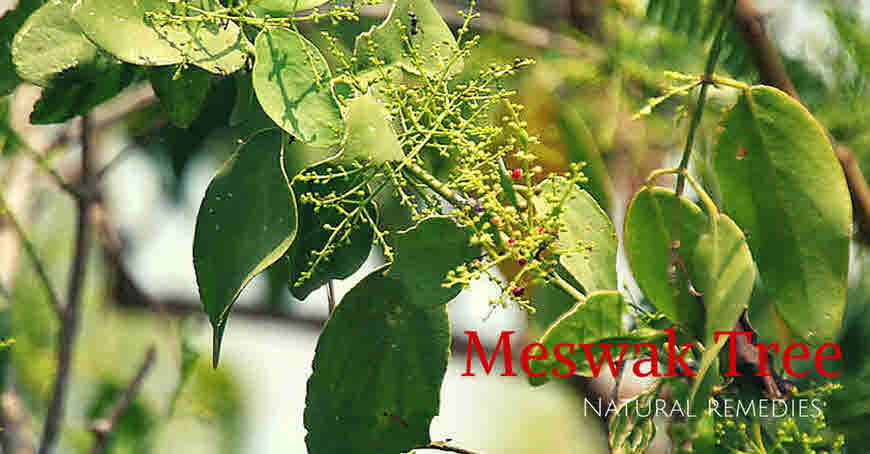Meswak is a large shrub or small tree that grows in arid region from west India to Africa. It is a typical desert plant that is found in extreme saline soil of Thar Desert. The latin name of Meswak is Salvadora persica and belongs to family Salvadoraceae. This tree is known as Toothbrush tree as the twigs are used for teeth cleaning from time immemorial. The fibrous branches have been promoted by the World Health Organization (WHO) for oral hygiene.

The other common medicinal uses of this tree are for treating rheumatism, leprosy, gonorrhea, ulcers, scurvy, tumors and dental diseases.
Scientific classification
Kingdom: Plantae Division: Magnoliophyta Class: Magnoliopsida Order: Brassicales Family: Salvadoraceae Genus: Salvadora Species: persica
Scientific name: Salvadora persica;Synonym: Salvadora persica L. var. wightiana Verde.;Salvadora indica Wt.
Vernacular names
- Sanskrit: Gudaphala, Lakhupeelu, Pilukaa
- Ayurvedic name: Pilu
- Unani name: Pilu, Miswak
- English: Salt Bush tree, Tooth Brush tree
- Hindi: Khara Jhal, Chota Pilu, Meswak
- Bengali: Peelugachh, Jhal
- Malayalam: Uka, Ukamaram
- Marathi: Khakan, Pilu
- Tamil: Kotumaavali, Chittuva, Perungoli, Udhaiputtai
- Telugu: Gogu, Varagogu, Gunia
- Kannada: Gonimara
- Trade name: Khara Jhal, Tooth Brush Tree
Distribution: Arid regions, on saline lands and in coastal regions.
Botanical description
Evergreen perennial slow growing small tree;reaches up to 10 meters in height and a girth of 3 feet;trunk erect or trailing, diameter more than one foot, branches crooked, straggling and profuse;
Leaves: 3 to 10 cm in length and 1 to 4 cm in breadth, green, simple, stipulate, petiolate, oblong, ovate, margin entire, broad at base and acute at apex;veins prominent and raised on lower surface;both surfaces glabrous;taste and odour characteristic.
Fruits: 3 to 5 mm in diameter, ellipsoid-ovoid, occasionally with a small pedicel attached;surface greenish or greenish-brown to dark brown in color, with irregular wrinkles, sometimes shrunken;pericarp thin, easily separable, exhibiting creamish to dull brown seed, odour characteristic and taste bitter.
Bark: slightly rough, greyish brown on main stem, paler elsewhere
New leaves during April and shed from late December to January;Flowers are small, greenish yellow produced in January to April;fruits ripens in the months of May and June;
Constituents
Fruits:?- sitosterol, sterol glycoside, benzyle isothioagnate, traces of alkaloid, fixed oil, sugar and fat, non-saponifiable portion of oil consists of dibenzylurea and dibenzlethiourea.
Leaf:?-sitosterol, glucotropaeolin, terpenes and flavonoids.
Roots:?-sitosterol and elementral ?- monoclinic sulfur (S-8) and glucotropaeolin isolated from root.
Traditional Medicinal uses
The most common medicinal use of Meswak tree is for oral care. Its twigs are used for teeth cleaning by chewing. This use gives the tree many names such as Chewing stick, Natural toothbrush and Miswak. Meswak sticks are very effective in preventing dental cavities. This is due to its antibacterial properties and presence of fluoride, chloride, silica, tannin, etc. Studies prove the strong anti-cavity effect is due to the presence of large amount of fluorides in it. Silica helps to remove stains and plaque. Tannins have as astringent action and reduces gingivitis and other dental diseases.
In studies it was shown, Miswak stick chewing produced significant increases in calcium (22-fold) and chloride (6-fold), and significant decreases in phosphate and pH. The saturation of saliva with calcium inhibits demineralization and promotes mineralization of tooth enamel, whereas high concentration of chloride inhibits calculus formation.
It also protects against gum irritation. Meswak tooth sticks relieves toothache, gum disease and prevents plaque. Meswak is also used in preparation of toothpaste.
Tree leaves have diuretic, analgesic, antibacterial and antifertility properties. Leaves are used for treating cough, and asthma, piles, tumors and scurvy. These are antidote to all type of poison. Leaf juice is given to treat vitamin C deficiency. The decoction is given to treat cough, cold, asthma, etc. In rheumatism, heated leaves are applied on the affected body areas. Poultice is applied on piles, tumors, etc. The leaves are also used as fodder. It increases lactation in cows.
The fruits are edible and have aphrodisiac, carminative, emollient and laxative. These are used to cures urinary calculi, biliary calculi and arthritis.
The seed oil is used in rheumatic pain, diabetes, spleen and stomach disorders.
The root bark of the tree is used to treat gonorrhea, general body pain, back pain, spleen trouble, headaches and stomach-aches. Roots are used for chest diseases.